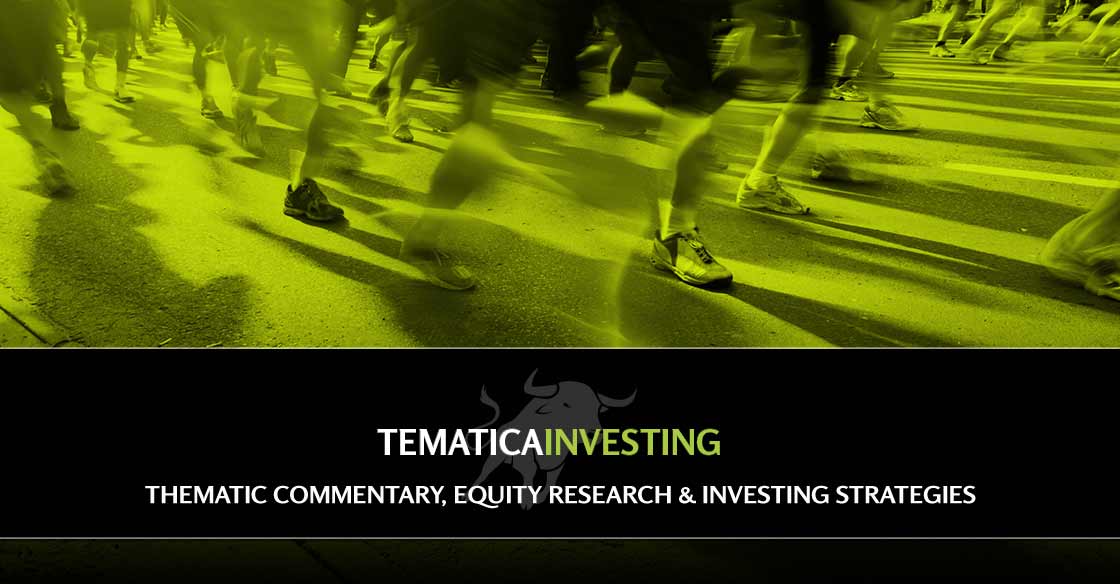WEEKLY ISSUE: Trade and Tariffs, the Words of the Week
KEY POINTS FROM THIS WEEK’S ISSUE:
- We are issuing a Sell on the shares of MGM Resorts (MGM) and removing them from the Tematica Investing Select List.
- While the markets are reacting mainly in a “shoot first and ask questions later” nature, given the widening nature of the recent tariffs there are several safe havens that patient investors must consider.
- We are recasting several of our Investment Themes to better reflect the changing winds.
Investor Reaction to All the Tariff Talk
Over the last two days, the domestic stock market has sold off some 16.7 points for the S&P 500, roughly 0.6%. That’s far less than the talking heads would suggest as they focus on the Dow Jones Industrial Average that has fallen more than 390 points since Friday’s close, roughly 1.6%. Those moves pushed the Dow into negative territory for 2018 and dragged the returns for the other major market indices lower. Those retreats in the major market indices are due to escalating tariff announcements, which are raising uncertainty in the markets and prompting investors to shoot first and ask questions later. We’ve seen this before, but we grant you the causing agent behind it this time is rather different.
What makes the current environment more challenging is not only the escalating and widening nature of the tariffs on more countries than just China, but also the impact they will have on supply chain part of the equation. So, the “pain” will be felt not just on the end product, but rather where a company sources its parts and components. That means the implications are wider spread than “just” steel and aluminum. One example is NXP Semiconductor (NXPI), whose chips are used in a variety of smartphone and other applications – the shares are down some 3.7% over the last two days.
With trade and tariffs being the words of the day, if not the week, we have seen investors bid up small-cap stocks, especially ones that are domestically focused. While the other major domestic stock market indices have fallen over the last few days, as we noted above, the small-cap, domestic-heavy Russell 2000 is actually up since last Friday’s close, rising roughly 8.5 points or 0.5% as of last night’s market close. Tracing that index back, as trade and tariff talk has grown over the last several weeks, it’s quietly become the best performing market index.
A Run-Down of the Select List Amid These Changing Trade Winds
On the Tematica Investing Select List, we have more than a few companies whose business models are heavily focused on the domestic market and should see some benefit from the added tailwinds the international trade and tariff talk is providing. These include:
- Costco Wholesale (COST)
- Dycom Industries (DY)
- Habit Restaurants (HABT)
- Farmland Partners (FPI)
- LSI Industries (LYTS)
- Paccar (PCAR)
- United Parcel Services (UPS)
We’ve also seen our shares of McCormick & Co. (MKC) rise as the tariff back-and-forth has picked up. We attribute this to the inelastic nature of the McCormick’s products — people need to eat no matter what — and the company’s rising dividend policy, which helps make it a safe-haven port in a storm.
Based on the latest global economic data, it once again appears that the US is becoming the best market in the market. Based on the findings of the May NFIB Small Business Optimism Index, that looks to continue. Per the NFIB, that index increased in May to the second highest level in the NFIB survey’s 45-year history. Inside the report, the percentage of business owners reporting capital outlays rose to 62%, with 47% spending on new equipment, 24% acquiring vehicles, and 16% improving expanded facilities. Moreover, 30% plan capital outlays in the next few months, which also bodes well for our Rockwell Automation (ROK) shares.
Last night’s May reading for the American Trucking Association’s Truck Tonnage Index also supports this view. That May reading increased slightly from the previous month, but on a year over year basis, it was up 7.8%. A more robust figure for North American freight volumes was had with the May data for the Cass Freight Index, which reported an 11.9% year over year increase in shipments for the month. Given the report’s comment that “demand is exceeding capacity in most modes of transportation,” I’ll continue to keep shares of heavy and medium duty truck manufacturer Paccar (PCAR) on the select list.
The ones to watch
With all of that said, we do have several positions that we are closely monitoring amid the escalating trade and tariff landscape, including
- Apple (AAPL),
- Applied Materials (AMAT)
- AXT Inc. (AXTI)
- MGM Resorts (MGM)
- Nokia (NOK)
- Universal Display (OLED)
With Apple we have the growing services business and the eventual 5G upgrade cycle as well as the company’s capital return program that will help buoy the shares in the near-term. Reports that it will be spared from the tariffs are also helping. With Applied, China is looking to grow its in-country semi-cap capacity, which means semi- cap companies could see their businesses as a bargaining chip in the short-term. Longer- term, if China wants to grow that capacity it means an eventual pick up in business is likely in the cards. Other drivers such as 5G, Internet of Things, AR, VR, and more will spur incremental demand for chips as well. It’s pretty much a timing issue in our minds, and Applied’s increased dividend and buyback program will help shield the shares from the worst of it.
Both AXT and Nokia serve US-based companies, but also foreign ones, including ones in China given the global nature of smartphone component building blocks as well as mobile infrastructure equipment. Over the last few weeks, the case for 5G continues to strengthen, but if these tariffs go into effect and last, they could lead to a short-term disruption in their business models. Last week, Nokia announced a multi-year business services deal with Wipro (WIT) and alongside Nokia, Verizon (VZ) announced several 5G milestones with Verizon remaining committed to launching residential 5G in four markets during the back half of 2018. That follows the prior week’s news of a successful 5G test for Nokia with T-Mobile USA (TMUS) that paves the way for the commercial deployment of that network.
In those cases, I’ll continue to monitor the trade and tariff developments, and take action when are where necessary.
Pulling the plug on MGM shares
With MGM, however, I’m concerned about the potential impact to be had not only in Macau but also on China tourism to the US, which could hamper activity on the Las Vegas strip. While we’re down modestly in this Guilty Pleasure company, as the saying goes, better safe than sorry and that has us cutting MGM shares from the Select List.
- We are issuing a Sell on the shares of MGM Resorts (MGM) and removing them from the Tematica Investing Select List
Sticking with the thematic program
On a somewhat positive note, as the market pulls back we will likely see well-positioned companies at better prices. Yes, we’ll have to navigate the tariffs and understand if and how a company may be impacted, but to us, it’s all part of identifying the right companies, with the right drivers at the right prices for the medium to long-term. That’s served us well thus far, and we’ll continue to follow the guiding light, our North Star, that is our thematic lens. It’s that lens that has led to returns like the following in the active Tematica Investing Select List.
- Alphabet (GOOGL): 60%
- Amazon (AMZN): 133%
- Costco Wholesale (COST) : 30%
- ETFMG Prime Cyber Security ETF (HACK): 34%
- USA Technologies (USAT): 62%
Over the last several weeks, we’ve added several new positions – Farmland Partners (FPI), Dycom Industries (DY), Habit Restaurant (HABT) and AXT Inc. (AXTI) to the active select list as well as Universal Display (OLED) shares. As of last night’s, market close the first three are up nicely, but our OLED shares are once again under pressure amid rumor and speculation over the mix of upcoming iPhone models that will use organic light emitting diode displays. When I added the shares back to the Select List, it hinged not on the 2018 models but the ones for 2019. Let’s be patient and prepare to use incremental weakness to our long-term advantage.
Recasting Several of our investment themes
Inside Tematica, not only are we constantly examining data points as they relate to our investment themes we are also reviewing the investing themes that we have in place to make sure they are still relevant and relatable. As part of that exercise and when appropriate, we’ll also rename a theme.
Over the next several weeks, I’ll be sharing these repositions and renamings with you, and then providing a cheat sheet that will sum up all the changes. As I run through these I’ll also be calling out the best-positioned company as well as supplying some examples of the ones benefitting from the theme’s tailwinds and ones marching headlong into the headwinds.
First up, will be a recasting of our Rise & Fall of the Middle-Class theme. As the current name suggests, there are two aspects of this theme — the “Rise” and the “Fall” part. It can be confusing to some, so we’re splitting it into two themes. The “Rise” portion will be “The New Global Middle Class” and will reflect the rapidly expanding middle class markets particularly in Asia and South America. On the other hand, the “Fall” portion will be recast as “The Middle Class Squeeze” to reflect the shrinking middle class in the United States and the realities that poses to our consumer-driven economy.
We’ll have a detailed report to you in the coming days on the recasting of these two themes, how it impacts the current Select List as well as other companies we see as well-positioned given the tailwinds of each theme.




